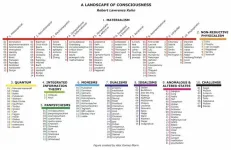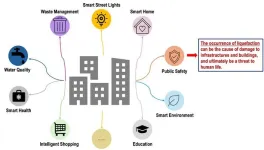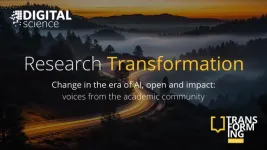(Press-News.org) “Out of meat, how do you get thought? That’s the grandest question.” So said philosopher Patricia Churchland to Robert Lawrence Kuhn, the producer and host of the acclaimed PBS program, Closer to Truth. Now Kuhn, a member of FQxI’s scientific advisory council, has published a taxonomy of proposed solutions to, and theories regarding, the hard problem of consciousness. He produced the organizing framework in order to explore their impact on meaning, purpose and value (if any), AI consciousness, virtual immortality, survival beyond death, and free will. Kuhn's ‘landscape of consciousness’ was published in the journal Progress in Biophysics and Molecular Biology in its August 2024 issue.
Closer To Truth has aired 333 television episodes since 2000, including 30 in partnership with the Foundational Questions Institute, FQxI, the science think tank and funding agency. Kuhn’s article is the product of some of his many in-depth interviews with experts over the decades. “I have discussed consciousness with over 200 scientists and philosophers,” says Kuhn, who is himself trained in neurophysiology. “Landscape is the product of a lifetime.”
“I have discussed consciousness with over 200 scientists and philosophers. Landscape is the product of a lifetime,” says Kuhn.
The article begins with the classic mind-body problem: How do the felt experiences in our minds relate to the neural processes in our brains? How do mental states, whether sensory, cognitive, emotional, or even noumenal (self-less) awareness, correlate with brain states? “Although there are families of mind-body problems, I focus tightly on phenomenal consciousness: our inner awareness, ‘what it feels like to be’ something,” says Kuhn.
Kuhn presents diverse theories of consciousness from materialist/physicalist to nonmaterialist/nonphysicalist. These are categorized as: Materialism Theories (philosophical, neurobiological, electromagnetic field, computational and informational, homeostatic and affective, embodied and enactive, relational, representational, language, phylogenetic evolution); Non-Reductive Physicalism; Quantum Theories; Integrated Information Theory; Panpsychisms; Monisms; Dualisms; Idealisms; Anomalous and Altered States Theories; and Challenge Theories. “Each explanation is self-described by its adherents,” notes Kuhn.
The taxonomy is laid out in the accompanying figure.
Seeking Insights
“My purpose must be humble: collect and categorize, not assess and adjudicate,” says Kuhn. “Seek insights, not answers.” Kuhn produced the organizing framework for these diverse theories of consciousness in order to explore their impact on “ultimate questions,” such as meaning, purpose and value (if any), AI consciousness, virtual immortality, survival beyond death, and free will, he says. “Understanding consciousness at this point cannot be limited to selected ways of thinking or knowing, but should seek expansive yet rational diversity.”
“Understanding consciousness at this point cannot be limited to selected ways of thinking or knowing, but should seek expansive yet rational diversity," says Kuhn.
Having produced an article of around 175,000 words, Kuhn found that his opinions on certain proposals had evolved. “My own hunch, right here, right now might be something of a Dualism-Idealism mashup. Second place might go to some form of Quantum Consciousness, triggered by writing this paper and surprising me. Third place, counterintuitively, to a kind of Eliminative Materialism/Illusionism, combined with Neurobiological and Representational Theories.”
But, adds Kuhn, “Smart, serious folks believe radically different theories; what I believe doesn’t much matter.”
You can read more about Kuhn’s writing process and his thoughts on consciousness in his FQxI article: “A Landscape of Consciousness.”
Journal reference, Progress in Biophysics and Molecular Biology: A Landscape of Consciousness: Toward a Taxonomy of Explanations and Implications
ABOUT FQxI
The Foundational Questions Institute, FQxI, catalyzes, supports, and disseminates research on questions at the foundations of science, particularly new frontiers in physics and innovative ideas integral to a deep understanding of reality but unlikely to be supported by conventional funding sources. Visit FQxI.org for more information.
ABOUT CLOSER TO TRUTH
Closer To Truth tackles fundamental issues of existence. It is a broadcast and digital media not-for-profit organization and series. On the air continuously since 2000, the weekly, half-hour television show airs on over 200 PBS and public TV stations. Closer To Truth is created, executive produced, hosted, and written by Robert Lawrence Kuhn, and co-created, produced, and directed by award-winning filmmaker Peter Getzels.
END
A landscape of consciousness
A taxonomy of explanations for the origin and mechanics of consciousness by Robert Lawrence Kuhn
2024-10-28
ELSE PRESS RELEASES FROM THIS DATE:
Towards implementing neural networks on edge IoT devices
2024-10-28
There are, without a doubt, two broad technological fields that have been developing at an increasingly fast pace over the past decade: artificial intelligence (AI) and the Internet of Things (IoT). By excelling at tasks such as data analysis, image recognition, and natural language processing, AI systems have become undeniably powerful tools in both academic and industry settings. Meanwhile, miniaturization and advances in electronics have made it possible to massively reduce the size of functional devices capable ...
Co-culture system for sustainable cultured meat production
2024-10-28
There is a pressing need for environmentally friendly meat production technologies to tackle the increasing global food demand. Cultured meat production is one such technology that is attracting a lot of attention as an alternative to conventional meat production. First developed in 2012, cultured meat is simply meat that is produced by growing or culturing muscle cells from animals in a laboratory.
Typically, cultured meat production requires serum (or the liquid part of the blood) from animals, which is essential for the growth of muscle cells in the culture medium since serum includes abundant proteins that promote muscle cell growth. ...
Breakthrough in 3D object scanning: Boosting clarity and depth perception for complex structures
2024-10-28
Recent advances in three-dimensional (3D) scanning, particularly in photogrammetry and laser scanning, have made it possible to quickly and accurately scan complex 3D objects in the real world. These techniques generate detailed models by collecting large-scale point cloud data, representing the object's surface geometry through millions of individual points. This technology has applications in different fields, such as the 3D scanning of cultural heritage objects. By preserving these objects in digital formats, ...
Building safer cities with AI: Machine learning model enhances urban resilience against liquefaction
2024-10-28
As urban areas expand, the threat of natural disasters becomes a pressing concern for city planners and disaster management authorities. In earthquake-prone countries like Japan, one of the critical risks to infrastructure is liquefaction, a phenomenon where intense shaking causes loose, water-saturated soils to lose their strength and behave like a liquid. Liquefaction can cause buildings to sink into the soil, crack foundations, and collapse roads and utilities like water lines.
Soil liquefaction accompanies every major earthquake, and the damage is significant. The 2011 Tōhoku earthquake in Japan caused liquefaction ...
Novel self-cleaning electrode developed for alkaline-earth metal peroxide synthesis
2024-10-28
Metal peroxide (MO2, M=Ca, Sr, Ba) is an alternative to hydrogen peroxide (H2O2). It has excellent oxidative properties, superior chemical stability, high purity, and is easy to store and transport. It has been widely used in wastewater treatment and disinfection.
A Chinese research group has recently developed a novel self-cleaning electrode by constructing a micro-/nanostructure of a highly active catalyst with appropriate surface modification, achieving highly stable synthesis of alkaline-earth MO2.
This study was published in Nature Nanotechnology.
The current primary synthesis process of MO2 involves fast decomposition of H2O2, leading to insufficient utilization ...
New report demands greater understanding of the impact of change on academia
2024-10-28
Digital Science, a technology company serving stakeholders across the research ecosystem, is today calling for greater awareness of the impact that a myriad of fast-developing technologies are having on academics and their institutions.
This follows the publication of a new report from Digital Science looking at how changing attitudes and behaviors towards research are affecting traditional research models and dynamics. Key themes to emerge from the findings relate to areas of open research, impact and evaluation, tech and AI, collaboration and research security.
The objective of the report – titled Research Transformation: Change in the era of AI, open and impact ...
Discovery of key mechanism in Huntington’s Disease could pave the way for early detection and treatment
2024-10-28
Researchers from the University of Oxford have identified a key biochemical mechanism relevant to the development of Huntington’s Disease. This discovery opens up the possibility of studying the disease before its clinical onset and eventually stopping its progression.
The study, published in Nature Metabolism, has shown for the first time the biochemical change responsible for the development of Huntington’s disease, and how blocking this change stopped disease progression.
Huntington's disease is an inherited condition that stops parts of the brain from working properly, leading to mental and physical decline that slowly ...
Humans and AI: Do they work better together or alone?
2024-10-28
The potential of human-AI collaboration has captured our imagination: a future where human creativity and AI's analytical power combine to make critical decisions and solve complex problems. But new research from the MIT Center for Collective Intelligence (CCI) suggests this vision may be much more nuanced than we once thought.
Published today in Nature Human Behaviour, “When Combinations of Humans and AI Are Useful” is the first large-scale meta-analysis conducted to better understand when human-AI combinations are useful in task completion, and when they are not. Surprisingly, the research has found that combining humans and AI to ...
Childhood attention issues and genetic factors may predict psychosis risk
2024-10-28
Researchers at UCLA Health have found that a person's risk of developing psychotic-like experiences may be influenced by both childhood attention problems and their genetic makeup.
The findings, published in Nature Mental Health, build upon a long-studied association between childhood attention problems and the likelihood of later developing schizophrenia. Using data from about 10,000 children over six years, UCLA researchers led by Dr. Carrie Bearden sought to determine how attentional variability ...
Amsterdam UMC study proves impact of rapid first shock after cardiac arrest
2024-10-28
It is well known that acting quickly in the event of a cardiac arrest is important, but what does a quick initial shock with a defibrillator mean exactly for patients' chances of survival? Researchers from Amsterdam UMC analysed the data of 3723 patients who had a cardiac arrest outside the hospital and concluded that for the first shock, every minute reduces the chance of survival by 6%. The results of this research were published today in the international journal Circulation.
"Our research shows that every minute of delay in giving the first shock has a major impact. If the first shock was given within six minutes, it was possible ...
LAST 30 PRESS RELEASES:
Studies investigate how AI can aid clinicians in analyzing medical images
Researchers pitch strategies to identify potential fraudulent participants in online qualitative research
Sweeping study shows similar genetic factors underlie multiple psychiatric disorders
How extreme weather events affect agricultural trade between US states
Smallholder farms maintain strong pollinator diversity – even when far from forests
Price of a bot army revealed across hundreds of online platforms worldwide – from TikTok to Amazon
Warblers borrow color-related genes from evolutionary neighbors, study finds
Heat signaling from plants is an ancient pollinator signal
New index reveals the economics underlying the online manipulation economy
High-resolution satellite observations reveal facility-level methane emissions worldwide
Researchers discover how Ebola and Marburg disrupt the gastrointestinal tract
Feeling the heat
Eastward earthquake rupture progression along the Main Marmara Fault towards Istanbul
Scientists uncover how Earth’s mantle locked away vast water in early magma ocean
Scientists uncover key driver of treatment-resistant cancer
Rare image of Tatooine-like planet is closest to its twin stars yet
Music: Popular song lyrics have become more negative since 1973
Marine ecology: Killer whales tail dolphins to hunt salmon
ADHD prescriptions on the rise, study finds
How to build a genome
Sharp rise in ADHD stimulant prescriptions in Ontario, research finds
Trends and prevalence of the metabolic syndrome among US adults
Population-level trends in ADHD medication prescribing
Missing piece of myelin disturbs the brain’s rhythm
Insilico Medicine and Taigen achieves license agreement to develop and commercialize AI-driven PHD inhibitor for anemia of Chronic Kidney Disease (CKD)
Exploring dominant endophytic Pleosporales in grasses: New taxonomic insights in the suborder Massarineae
Comparative transcriptomic analysis of human maxillary and mandibular tooth germs reveals discrepancies in gene expression patterns
Scientists detect atmosphere on molten rocky exoplanet - study
Chip-scale magnetometer uses light for high-precision magnetic sensing
Illinois Tech biomedical engineering professor Philip R. Troyk elected as Fellow of the National Academy of Inventors
[Press-News.org] A landscape of consciousnessA taxonomy of explanations for the origin and mechanics of consciousness by Robert Lawrence Kuhn







